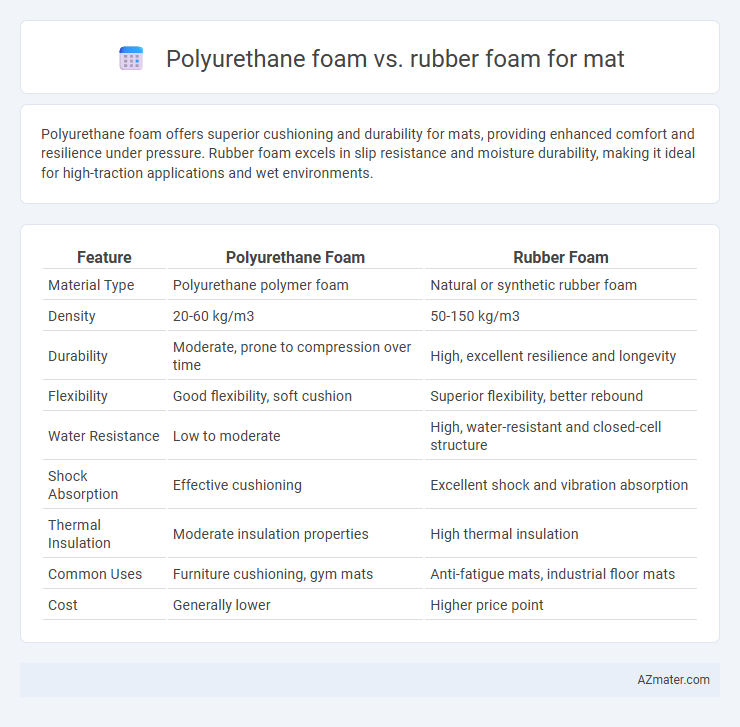Polyurethane foam offers superior cushioning and durability for mats, providing enhanced comfort and resilience under pressure. Rubber foam excels in slip resistance and moisture durability, making it ideal for high-traction applications and wet environments.
Table of Comparison
| Feature | Polyurethane Foam | Rubber Foam |
|---|---|---|
| Material Type | Polyurethane polymer foam | Natural or synthetic rubber foam |
| Density | 20-60 kg/m3 | 50-150 kg/m3 |
| Durability | Moderate, prone to compression over time | High, excellent resilience and longevity |
| Flexibility | Good flexibility, soft cushion | Superior flexibility, better rebound |
| Water Resistance | Low to moderate | High, water-resistant and closed-cell structure |
| Shock Absorption | Effective cushioning | Excellent shock and vibration absorption |
| Thermal Insulation | Moderate insulation properties | High thermal insulation |
| Common Uses | Furniture cushioning, gym mats | Anti-fatigue mats, industrial floor mats |
| Cost | Generally lower | Higher price point |
Introduction to Polyurethane Foam and Rubber Foam
Polyurethane foam is a versatile, lightweight material known for its excellent cushioning properties, durability, and resistance to compression, making it ideal for various mat applications. Rubber foam, derived from natural or synthetic rubber, offers superior elasticity, shock absorption, and resistance to wear and tear, which enhances the longevity and comfort of mats. Both materials provide unique benefits, with polyurethane foam excelling in softness and flexibility while rubber foam delivers robustness and enhanced grip.
Composition and Material Properties
Polyurethane foam, composed of polymer chains derived from polyols and isocyanates, offers excellent cushioning, flexibility, and good thermal insulation due to its open-cell or closed-cell structure. Rubber foam, primarily made from natural or synthetic rubber such as Neoprene or EPDM, provides superior elasticity, abrasion resistance, and enhanced durability under mechanical stress and varying temperatures. The choice between polyurethane and rubber foam mats depends on factors like density, resilience, moisture resistance, and application-specific performance requirements.
Comfort and Cushioning Comparison
Polyurethane foam offers superior comfort and cushioning for mats due to its high density and excellent shock absorption properties, providing consistent support over extended use. Rubber foam, known for its durability and resilience, delivers firmer cushioning ideal for heavy-impact activities but may lack the plush softness found in polyurethane alternatives. The choice between polyurethane foam and rubber foam depends on the desired balance between comfort and durability, with polyurethane excelling in softness and rubber foam in long-lasting support.
Durability and Lifespan
Polyurethane foam offers superior durability with excellent resistance to abrasion, impact, and compression, making it ideal for mats subjected to heavy use and prolonged pressure. Rubber foam provides strong resilience and recovery, maintaining shape and cushioning over time, but it can degrade faster under UV exposure and certain chemicals. Lifespan of polyurethane foam mats typically exceeds 10 years in indoor environments, while high-quality rubber foam mats last around 5 to 7 years depending on usage and environmental factors.
Moisture and Water Resistance
Polyurethane foam offers moderate moisture resistance but tends to absorb water over time, making it less ideal for prolonged wet conditions. Rubber foam, especially closed-cell varieties like neoprene, provides superior water resistance and prevents moisture infiltration, enhancing durability and comfort in damp environments. For mats exposed to high humidity or direct water contact, rubber foam ensures longer-lasting performance and better protection against mold and mildew.
Insulation and Temperature Regulation
Polyurethane foam offers superior thermal insulation due to its closed-cell structure, effectively minimizing heat transfer and maintaining consistent temperature levels across surfaces. Rubber foam excels in temperature regulation by providing flexibility and resilience under varying thermal conditions, which helps absorb temperature fluctuations and reduce thermal shock. Both materials improve comfort and energy efficiency, but polyurethane foam is preferred for high-performance insulation, while rubber foam is ideal for dynamic environments requiring temperature adaptability.
Weight and Portability
Polyurethane foam mats are significantly lighter than rubber foam mats, enhancing portability for activities like camping and yoga. The lower density of polyurethane foam reduces overall mat weight without sacrificing cushioning, making it ideal for users who prioritize ease of transport. Rubber foam mats, while heavier, offer durable material but can be cumbersome to carry over long distances.
Safety and Allergen Concerns
Polyurethane foam mats often emit volatile organic compounds (VOCs) that can trigger respiratory issues and skin irritation, posing safety concerns for sensitive individuals. Rubber foam mats, especially those made from natural latex, may cause allergic reactions ranging from mild skin irritation to severe anaphylaxis in individuals with latex allergies. Choosing non-toxic, hypoallergenic options with certifications such as OEKO-TEX or GREENGUARD can mitigate risks associated with both polyurethane and rubber foam mats.
Cost and Value Analysis
Polyurethane foam mats offer a lower initial cost compared to rubber foam mats, making them a budget-friendly option for various applications. Rubber foam provides superior durability and resistance to wear, delivering greater long-term value despite higher upfront expenses. Evaluating total cost of ownership, polyurethane foam suits short-term or lightweight use, while rubber foam outperforms in heavy-duty, high-traffic environments.
Best Applications for Each Foam Type
Polyurethane foam excels in cushioning and sound insulation, making it ideal for mattress toppers, furniture padding, and acoustic panels due to its flexibility and durability. Rubber foam offers superior shock absorption and water resistance, making it suitable for exercise mats, yoga mats, and industrial anti-fatigue mats where slip resistance and resilience are critical. Choosing between polyurethane and rubber foam depends on the specific performance needs such as comfort, moisture resistance, or impact absorption in the intended application.

Infographic: Polyurethane foam vs Rubber foam for Mat
 azmater.com
azmater.com